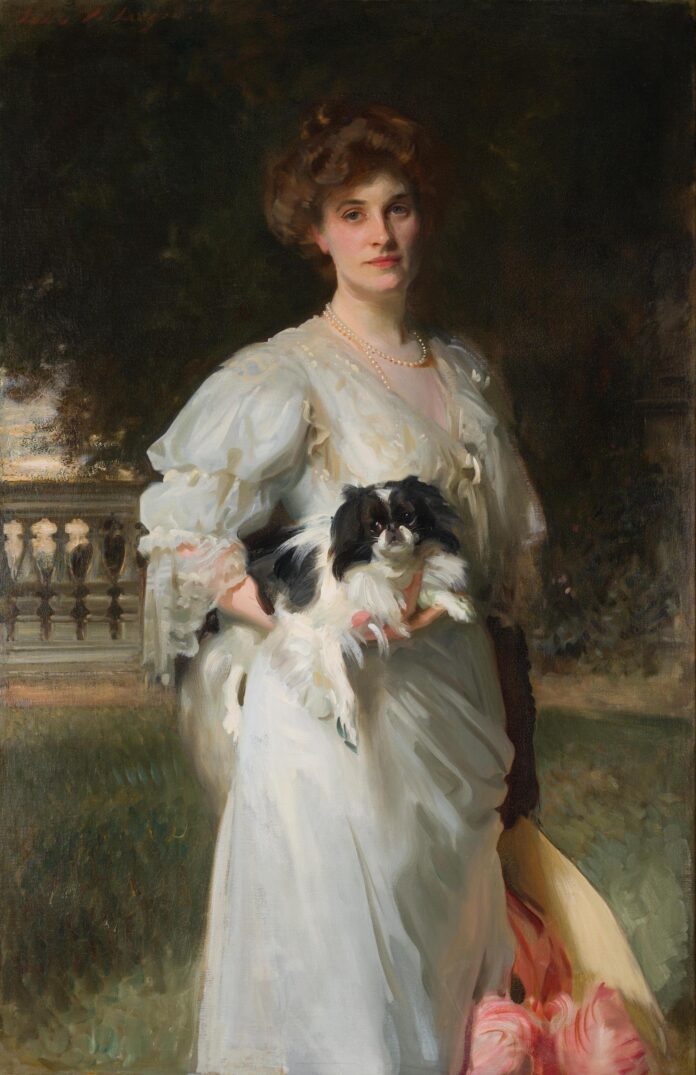John Singer Sargent, the American society portraitist, and Amelia Earhart, the daredevil American aviator, may belong together in some kind of national pantheon, but it’s hard to imagine them ever crossing paths. Now, a missing link between the two has resurfaced—Sargent’s stately 1905 portrait of socialite and philanthropist Amy Phipps Guest, who sponsored Earhart’s crucial first transatlantic flight in 1928.
This week the Norton Museum of Art in West Palm Beach, Florida, announced that it has acquired Portrait of Mrs. Frederick Guest (Amy Phipps), a nearly five-foot-tall work from the artist’s peak as a chronicler of the Anglo-American elite.
Amy Phipps Guest (1872-1959) was the daughter of Henry Phipps, Jr, a business partner of Pennsylvania steel magnate Andrew Carnegie, and the portrait was commissioned to commemorate her wedding to Frederick Edward Guest—known as Freddie—who was a grandson of the 7th Duke of Marlborough. The painting is a gift from Phipps Guest’s grandson, Alexander M. D. C. Guest, and the Guest family.
Phipps Guest sat for the portrait in Sargent’s now-legendary London studio, on Tite Street in Chelsea. It contains the artist’s signature touches, says Paul Fisher, a professor of American studies at Wellesley College and author of The Grand Affair: John Singer Sargent and His World, published last year. Instantly recognizable as a Sargent, the portrait features a luscious 18th-century-style landscape in the background, rendered in Sargent’s distinctive loose brushwork.
Fisher says the scene’s decorative balustrade was one of Sargent’s “amazing props”—part of a cache of “priceless antiques”, he adds, “that were catalogued and sold when he died”. He compares the architectural fragment to the sitter’s pearls as an “accouterment of status”.
Phipps Guest and her husband were early devotees of flying. In the early 1920s, Freddie Guest, a liberal Member of Parliament, was Britain’s Secretary of State for Air (following in the footsteps of his cousin, Winston Churchill). By this time, the couple had separated, and Phipps Guest, with grand Long Island and Palm Beach residences, had mounting ambitions to follow in Charles Lindbergh’s proverbial footsteps and become the first woman to fly across the Atlantic. She organised a plane and a flight crew, but after her family convinced her it was too dangerous, she suggested a substitute. Earhart, an amateur pilot then working as a Boston social worker, took her place.
In 1928, a year after Lindbergh’s solo crossing, Earhart—who, for this flight, was more of a symbolic passenger than pilot—and the crew completed the journey from Newfoundland to Wales in under 21 hours. Under Phipps Guest’s publicised sponsorship, the crossing made the photogenic Earhart, known as “Lady Lindy”, an A-list celebrity. Her later 1937 disappearance over the Pacific, part of an attempt to fly around the world, was one of the biggest news stories of its era.
The Sargent portrait of Earhart’s sponsor made a splash in 1906, when it was exhibited at London’s Royal Academy. But it hasn’t been shown in public since the 1940s and hasn’t been hung at all in 20 years. The work’s previous longtime owner was Phipps Guest’s daughter-in-law, socialite and Duke of Windsor confidant C.Z. Guest. She died in 2003 and the portrait has been “in storage ever since”, says her son, Alexander Guest. The painting was officially handed over to the Norton in late 2022.
Guest, a Miami-based gemmologist and jewellery specialist, says he chose the West Palm Beach institution over larger museums like New York’s Metropolitan Museum of Art and the Frick Collection so that his grandmother’s portrait could be “a star” and not “end up in the basement”, which can happen to the best of paintings in larger collections.

John Singer Sargent Study for “The Danaïdes” Mural at the Museum of Fine Arts, Boston, 1921-25 Courtesy the Norton Museum of Art
The Norton has placed its new Sargent in an installation with classical themes, displaying it along with the artist’s 1920s charcoal-on-paper study for The Danaïdes, a grand mural commissioned by Boston’s Museum of Fine Arts, finished near the end of his life.
In 1907, not long before he closed his Chelsea studio, Sargent painted Phipps Guest’s mother and infant son, Winston Guest (Alexander’s father). That work, which echoes the earlier Phipps Guest portrait, is on view at Old Westbury Gardens, the Long Island estate built by Amy Phipps Guest’s brother, John Shaffer Phipps, now open to the public.
Both Phipps works were made at a time when Sargent was growing weary of painting society ladies, says Fisher. During the Tite Street sittings, he says, the artist would sometimes go behind a screen to stick out his tongue in frustration. And he would say to friends, alluding to plans to swear off the line of work that had made him rich and famous, “No more mugs.”

























